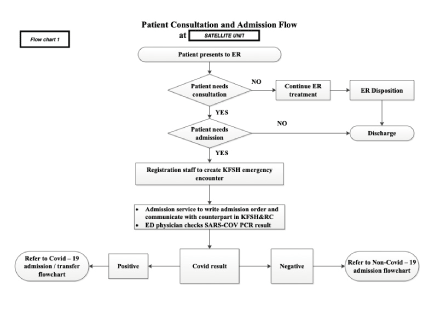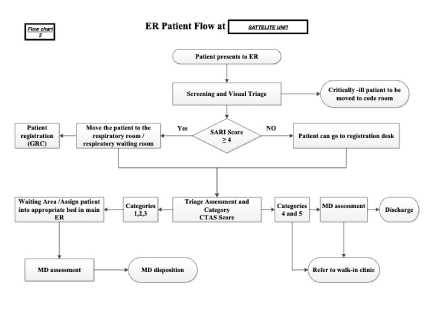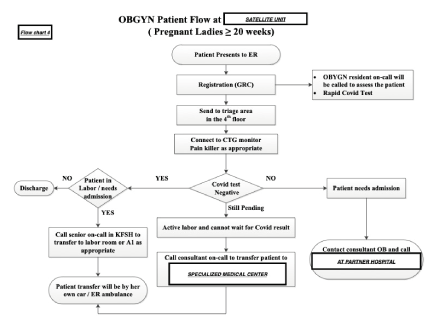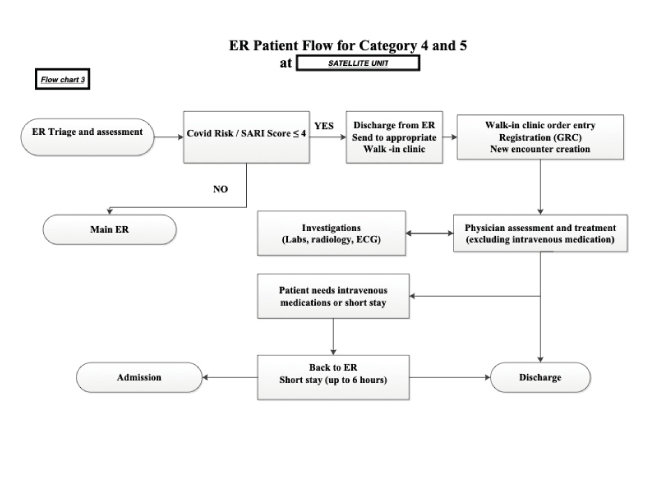King Faisal specialist Hospital and research centre (KFSH&RC) emergency department (ED) had to move its operational services to a distant satellite unit (SU) temporarily for 2 weeks in the middle of the COVID-19 pandemic peak season. The move was inevitable and had to be carried out at a short notice.
Aim: Whether our ED had analyzed all the risks prior to making this transfer? Did the planning take in to consideration all the risks involved and discussed the mitigation plan? Was there any serious untoward incidents directly related with this move?
Methods: We analyzed all the preparatory meetings, flow processes, protocols, number of ED patients transferred and safety related incidents during this period.
Outcomes: Moving an ED is a laborious process which has to be carried out in an appropriate time frame with adequate preparedness and appropriate risk management.
KFSH&RC ED had to relocate itself in the middle of the COVID-19 crisis, due to pressing reasons. It had to transfer its services to a smaller satellite unit (SU), couple of miles away from the parent hospital.
Intra hospital transfer of Emergency department (ED) within the same building carries a huge risk but when the new location is physically away, the risk gets multiplied. In the midst of a COVID-19 crisis, it was like lowering the guards against a tsunami [1].
The deadly COVID-19 crisis was reaching its peak during the first wave, when the highly vulnerable front end ED staff were given the herculean task of relocating the whole department, while continuing to provide the emergency services.
KFSH&RC ED protocols from delivery of life support to sitting arrangements in the ED waiting room had just been made COVID-19 compliant, when the decision to relocate the ED within two weeks was announced [2].
The ED staff had to go back to the drawing board and brainstorm a strategy for this new challenge, which could not have come at a more difficult time. The courageous staff despite the ongoing battle with COVID-19 took this new challenge head on.
We wanted to highlight the risks posed around this move and the counter measures, which made this move possible, in a short frame of time.
Risk assessment
The SU had to function as the main receiving site. Main ED at KFSH&RC was to stay partly operational to look after existing admitted/boarded patients and to receive patients from the SU, who needed admission under a speciality. No new patients were to be accepted at the KFSH&RC site, as the triage was not operational.
There was a total of 14 planning and preparation management meetings over the 2 weeks period prior to ED relocation. Potential risks around this move were classified as follows:
Risk to patients
Morbidity and mortality: Whilst delay in transferring an ED resuscitated patient to an appropriate clinical environment increases mortality, adding journey time increases that risk further [3]. KFSH&RC emergency department treats a very sick group of patients, as the hospital is the main provider of cancer and transplant services. Majority of its patients belong to Canadian Triage & assessment score (CTAS) category 3 and 2 (high acuity patients) and need close nursing care. Transferring these patients back to the main KFSH&RC ED, after initial resuscitation at the satellite unit was going be challenging.
Inappropriate allocation of clinical space: Translocation of patients to a less clinically equipped environment can happen during transfers. This contributes to patients morbidity.
Lack of specialities onsite: KFSH&RC is highly sub-specialised and ED is backed up by all specialities on site. The new satellite location only had limited in house speciality presence. Delay in speciality input slows down patient care.
Things done in a rush: A short time frame for transfer leads to a multitude of problems including less skilled staff transferring patients, untimely transportation and inadequate preparation at the recipient unit. Lack of accompanying documentation can be the last nail in the coffin.
Cumbersome for the patients to travel: The ambulatory patients who arrive using their own means of transport to KFSH&RC may find it cumbersome to travel to a satellite unit. They may go untreated and return back later, clinically deteriorated.
Lack of integrated patient information and computer (ICS): The patient clinical documentation at both sites could not be integrated. The patients’ previous electronic medical records at the main site were not retrievable at the satellite location.
Risks to staff
Incomplete orientation and training: Due to short time frame, all the staff may not be able to visit the new unit in advance. This lack of in house acquaintance can be a huge risk to patients and staff [4].
Inability to cope in the new environment: The staff abilities, skills and strengths may not fully unlock in the new environment, especially if the environment is unfamiliar. Even with full capability put in place, there can be significant issues to adjust within a new environment.
Poor morale: Poorly oriented staff carry a low morale, which can lead to decrease in productivity. That consequentially has an effect on patient care delivery.
Unable to contribute: Lack of staff preparedness and proactive involvement in such moves can create a feeling of not being valued and discourages staff engagement in future endeavours.
Staff sustainability: The staff recruitment and particularly retention becomes a challenge when they feel less protected and exposed to health risk. Making them work in unsafer environment could be a recipe for unsustainable workforce.
Underestimation of risk: Some staff can be totally unaware of the risks acquired from a new working environment. They can be a risk to themselves, other staff and patients. These staff normally would have worked in supervised roles, which becomes difficult during sudden moves.
Lack of team working: Involving all stakeholders and repetitive brain storming sessions closes most doors to risk intrusion and avoid flaws in strategies. Lack of team consultation and inability to communicate important decisions can quickly expose staff to risk [5].
Postponement of care: Inadequate staff deployment can happen with ad hoc work on two sites, which leads to delay and deferment of important tasks.
Lack of clear documentation: The lack of contemporaneous clinical notes can put the staff at risk of criticism, disciplinary action, litigation and risk of losing their job. The paper based documentation can be very fragile during major translocations but even a complete paperless system can crash, if prior threats have not been pre-empted [6].
Risk to the department
Poor risk management strategies: Just thinking everything will happen exactly as planned, is a fallacy. Unpredictable events catch the planners, even in well thought through processes. Less time spent in thinking, preparation and rehearsals is waiting for failure to happen [7].
The satellite location may not be conducive to provision of full tertiary care ED: If the recipient unit is not purpose built, it may not be able to cater the needs of a large tertiary care centre. The lay out may not encourage streaming and smooth flow of patients.
Integration with local teams: The local ED staff may not be geared up to help and manage a full blown tertiary care set up. This may make integration difficult with the local teams in the satellite unit [7].
Poor patient experience: Patients may not like the quality of care at the new site, added journey time and clinical interaction within the new environment. This can undermine departmental credibility. The hospital may loose patients as their expectations are not met in the new unit [8].
Poor communication: The staff while busy adapting to the new environment may not be able to provide the necessary clinical communication required by the patient. The patient relations team may not be as readily available to solve patient experience issues.
Lack of implementation of quality measures: New environment comes with new safety and quality issues, which may not come to light immediately. Unless the teams are experienced and have foreseen the issues, there is likely to be compromise on quality and lowering of the care standards [9].
Risks posed by COVID-19
The highly contagious and deadly COVID-19 taught care providers preventative measures, which seemed the only way to contain the disease. These measures inducted a behavioural change in KFSH&RC staff, which took a lot of time and motivation. Keeping them implemented at the new site was akin to climbing a mountain. There was certainly a risk of lack of adherence to the preventative measures hence the following threats were possible [10].
Transfer and spread of infection to patients and staff: KFSH&RC had multiple checks and barriers to stop COVID-19 intrusion. Clinical guards at doors of ED checking temperatures, protective screens at registration desks, pre-triage screening etc. All measures needed to be replicated, which could prove a serious challenge.
Loss of staff due to acquiring COVID-19 disease: That was a real threat due to staff’s inadvertent lack of compliance with preventative measures at the new location. Lack of workforce translates not only in deterioration in the level of patient care but also is stressful for other staff, who envisage that happening to them as well.
Safety risk for patients during transport from the main site: The patient carriage from the satellite unit to KFSH&RC ED was bound to break the shields, due to repeated manoeuvring of the patients. The already sick patient population can succumb due to additional clinical insults [11].
Mitigation strategies
Planning: The satellite ED unit was a newly built standard ED, which had been acquired by KFSH to move some of its services (including ambulatory ED patients), in a stepwise manner. Moving all the operational activity of KFSH&RC ED during peak COVID-19 period was not part of the initial plan.
When the crunch time came, a swift action plan was generated after involving all the stakeholders, which included clinical staff, ambulance services, nursing and management. The plan included a staged move of the operations, within the limited frame of time [12].
Training: Staff were subjected to paper exercises, quick drills about patient transfer especially for patients deteriorating on route.
Orientation: The visit to the new unit was encouraged for all staff before the planned move time. Staff were give relaxation from their clinical duties to help them acquaint with the new site.
Drills: Joint simulation exercises were carried out by the clinical staff and local teams at the new site in a short space of time.
Flow charts/Pathways/Protocols: There were clear patient flows for different patient clinical scenarios. The available services at the new site were utilised through pathways e.g the maternity services were utilised to fast track women in imminent labour to the local labour and delivery suite [13]. A total of 9 flow processes were created (Figures 1-4).

Figure 1. Consultation and Admission Flow Satellite Unit

Figure 2. EMS flow at Satellite Unit

Figure 3. OBGYN Patient Flow at Satellite Unit (20 weeks and above)

Figure 4. Patient Flow Cat 4 and 5 satellite Unit
Protocols for ST segment elevation myocardial infarction (STEMI code) and Stroke (stroke code) were revisited with inclusion of patient transfer from the satellite unit to main site without affecting the target treatment time.
Regular management meetings between the stakeholders: KFSH&RC management and local management at the SU worked tirelessly to carve out safe working environment for the patients and staff. Daily audit of the clinical flows was carried and lessons were learnt. On site presence of managers was ensured to provide immediate solutions to unseen issues.
Patient awareness and provision of shuttle service between the two sites: Regular patient awareness was carried out by the patient relation department directing them to appropriate locations. The front end security and ED reception staff were constantly engaged in signposting patients to satellite location, who presented to the main ED site. Shuttle service was also provided for the patients between the two sites.
Provision of speciality representatives on the satellite location: Whilst all the specialities could not be available on the satellite site, acute specialities (e.g internal medicine, cardiology) provided their representatives to be based in the SU for urgent response to ED patient consults [14].
Pharmacy provision: Patients discharged from the ED had provision of their take home prescriptions dispensed from the pharmacy on site.
Nursing contributory process
- Regular participation of the nurse leaders in the daily executive meeting to brainstorm strategies. ED head nurse split her time equally at two sites, with support from her assistants.
- Mobilisation of a critical mass of nursing staff from KFSH&RC to SU, whilst maintaining a balance at two sites.
- Senior nursing staff formed an adequate proportion of the daily workforce to provide orientation & support to their juniors.
- Mobilisation of equipment appropriately between two sites and ensuring functionality of the equipment at SU.
- Appropriate allocation and gearing up of rooms at the new location for running codes, provision of treatment, secondary triage etc.
- Communication channels between nurses and physicians were made robust between two sites. There were dedicated phone lines/pagers to summon urgent support.
- Daily huddles were arranged at both sites for staff support and also to address any issues found in previous shifts. These huddles were also a source of educating staff about newer arrangements.
- The senior nurses worked hand in hand with the physicians to create patient flow processes. Daily audits were also done to check adherence [15].
Specific challenges
-24 hrs coverage at two sites and maintaining a 30 minutes’ response time.
-Staff awareness about the new flow processes and familiarisation with the new ambulance parking and receiving areas.
-Appropriate deployment of ambulance vehicles, equipment and supplies at two sites to cope with the increase in service demand.
-Twenty four hours paramedics availability as part of the Medical Emergency Team (MET) during emergency codes.
-Communication challenges between different stakeholders at the SU and KFSH&RC.
Steps taken to overcome the challenges
-Patient transfers from SU to KFSH were prioritised to consistently hit the 30 minutes target. One ambulance was also kept on site at the SU at all times.
-Daily data report for ambulance response times and number of transfers was published.
-One paramedic at SU was made part of the MET to assure appropriate response to all codes. This paramedic was also responsible for daily orientation of the the other ambulance personnel attending the new site.
-An assigned paramedic also worked closely with the charge nurse at SU to ensure smooth patient flow during ambulance transfers
-Ambulance representatives joined the regular staff meetings/huddles to understand any additional areas of improvement[16].
Top Tips for transfer of patients from ED were distributed to staff
- Don’t be complacent – most of the transfers will go absolutely fine. Invest time in planning and preparation to avoid nightmare scenarios
- Optimise the patient. Follow the guidelines and ambulance transfer criteria.
- Package the patient, before you leave the ED bed space.
- Anticipate problems (e.g accidental extubation) – simulate these in your mind, make a plan and share it with your team.
- Prepare the recipient team at your destination.
- Choose the right team to go with the patient – those who can deal with the likely eventualities.
Review of safety related incidents: There was only one safety related incident recorded in the ED of the SU, which was classed as minor and was satisfactorily addressed.
Although we did not encounter any significant issues during this process but ED relocation should be a very carefully planned and well thought through process. A detailed insight in safety planning, preparedness and unforeseen operational risks should be at the hierarchy of such moves. Ample time should be invested for carving a big translocation move.
- Engle, Veronica. "Temporary relocation: Is it stressful to your patients." Journal of gerontological nursing 11, no. 10 (1985): 28-31.
- Qureshi, Muhammad Nauman, and Abdulaziz AlRajhi. "Challenge of COVID-19 crisis managed by emergency department of a big tertiary centre in Saudi Arabia." International Journal of Pediatrics and Adolescent Medicine 7, no. 3 (2020): 147-152.
- Richardson, Drew B. "Increase in patient mortality at 10 days associated with emergency department overcrowding." Medical journal of Australia 184, no. 5 (2006): 213-216.
- Patterson, Barbara, Elizabeth W. Bayley, Krista Burnell, and Jan Rhoads. "Orientation to emergency nursing: perceptions of new graduate nurses." Journal of emergency nursing 36, no. 3 (2010): 203-211.
- Shapiro, M. J., J. C. Morey, S. D. Small, V. Langford, C. J. Kaylor, L. Jagminas, S. Suner, M. L. Salisbury, R. Simon, and G. D. Jay. "Simulation based teamwork training for emergency department staff: does it improve clinical team performance when added to an existing didactic teamwork curriculum? " BMJ Quality & Safety 13, no. 6 (2004): 417-421.
- Kenneth, T. Yu, and Robert A. Green. "Critical aspects of emergency department documentation and communication." Emergency Medicine Clinics 27, no. 4 (2009): 641-654.
- Abraham, Louisa J., Ogilvie Thom, Jaimi H. Greenslade, Marianne Wallis, Amy NB Johnston, Eric Carlström, Donna Mills, and Julia Crilly. "Morale, stress and coping strategies of staff working in the emergency department: A comparison of two different‐sized departments." Emergency Medicine Australasia 30, no. 3 (2018): 375-381.
- Sonis, Jonathan D., Emily L. Aaronson, Rebecca Y. Lee, Lisa L. Philpotts, and Benjamin A. White. "Emergency department patient experience: a systematic review of the literature." Journal of patient experience 5, no. 2 (2018): 101-106.
- Borup, Jerry H. "The effects of varying degrees of interinstitutional environmental change on long-term care patients." The Gerontologist 22, no. 4 (1982): 409-417.
- Liu, Vincent, Patricia Kipnis, Norman W. Rizk, and Gabriel J. Escobar. "Adverse outcomes associated with delayed intensive care unit transfers in an integrated healthcare system." Journal of hospital medicine 7, no. 3 (2012): 224-230.
- Koh, David. "Occupational risks for COVID-19 infection." Occupational medicine (Oxford, England) 70, no. 1 (2020): 3.
- Mirotznik, Jerrold, and Asa P. Ruskin. "Inter-institutional relocation and its effects on health." The Gerontologist (1984).
- Jabbour, Mona, Janet Curran, Shannon D. Scott, Astrid Guttman, Thomas Rotter, Francine M. Ducharme, M. Diane Lougheed et al. "Best strategies to implement clinical pathways in an emergency department setting: study protocol for a cluster randomized controlled trial." Implementation science 8, no. 1 (2013): 1-11.
- Lee, Rene S., Rob Woods, Michael Bullard, Brian R. Holroyd, and Brian H. Rowe. "Consultations in the emergency department: a systematic review of the literature." Emergency Medicine Journal 25, no. 1 (2008): 4-9.
- Pruchno, Rachel A., and Nancy L. Resch. "The context of change: Disorientation following intra-institutional relocation." Journal of Applied Gerontology 8, no. 4 (1989): 465-480.
- Recio-Saucedo, Alejandra, Catherine Pope, Chiara Dall'Ora, Peter Griffiths, Jeremy Jones, Robert Crouch, and Jonathan Drennan. "Safe staffing for nursing in emergency departments: evidence review." Emergency Medicine Journal 32, no. 11 (2015): 888-894.
- Hovenkamp, Gijs Thomas, Tycho Joan Olgers, Remco Robert Wortel, Milou Esmée Noltes, Bert Dercksen, and Jan Cornelis Ter Maaten. "The satisfaction regarding handovers between ambulance and emergency department nurses: an observational study." Scandinavian journal of trauma, resuscitation and emergency medicine 26, no. 1 (2018): 1-6.
- Laughlin, Ann, Mary Parsons, Karl D. Kosloski, and Brenda Bergman-Evans. "Predictors of mortality following involuntary interinstitutional relocation." Journal of gerontological nursing 33, no. 9 (2007): 20-6.
- Mirotznik, Jerrold, and Asa P. Ruskin. "Inter-institutional relocation and its effects on psychosocial status." The Gerontologist 25, no. 3 (1985): 265-270.
- Canham, Sarah L., Mineko Wada, Lupin Battersby, Mei Lan Fang, and Andrew Sixsmith. "Experiences of a Mass Interinstitutional Relocation for Long-Term Care Staff." Journal of Housing For the Elderly 32, no. 2 (2018): 160-175.
- Ryman, Frida VM, Jetske C. Erisman, Lea M. Darvey, Jacob Osborne, Ella Swartsenburg, and Elena V. Syurina. "Health effects of the relocation of patients with dementia: A scoping review to inform medical and policy decision-making." The Gerontologist 59, no. 6 (2019).




